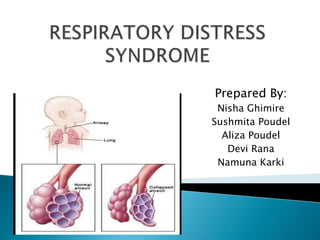
Respiratory distress syndrome
- 1. Prepared By: Nisha Ghimire Sushmita Poudel Aliza Poudel Devi Rana Namuna Karki
- 2. The term respiratory distress syndrome are most often applied to the severe lung disorder in neonate which is primarily related to lung immaturity. It is responsible for more infants death and neurological complications.
- 3. Respiratory distress syndrome is a syndrome of premature neonates that is characterized by progressive and usually fatal respiratory failure resulting from atelectasis and immaturity of lungs. It was formerly known as Hyaline membrane disease.
- 4. The breathing rate is usually more than 60 breaths per min and/or use of accesory muscle of respiration which maybe accompanied by grunting. Surfactant production starts around 20wks of life and peaks at 35wks . Therefore any neonate less than 35 wks is prone to develop RDS, without surfactant infants are unable to keep their lungs inflated.
- 5. The
- 6. Prematurity Asphyxia Hypothermia Maternal Anaemia Pre eclampsia Maternal diabetes Caesarian section
- 7. Pulmonary risk factors: Pneumonia Pneumothorax Congenital Malformation Upper airway obstruction eg: meconium aspiration syndrome
- 8. Non- pulmonary risk factors : Sepsis Cardiac defect Exposure to cold Hypoglycemia Metabolic acidosis Acute blood loss
- 9. In RDS, the basic abnormality is surfactant deficiency. It is lipoprotein containing phospholipids produced by type II alveolar cells of lungs and helps to reduce surface tension in alveoli.
- 10. During expiration, Absence of surfactant Surface tension increases Alveoli collapse
- 11. During inspiration, More negative pressure is needed to keep alveoli patent. Due to all these conditions, Inadequate Oxygenation Increased work of breathing Hypoxemia and acidosis
- 12. Pulmonary vasoconstriction Right to left shunting across foramen ovale Worsens Hypoxia Respiratory failure
- 13. Tachypnea (< or = 80 – 120 breaths per min) [Wong’s] Dyspnea Pronounced intercostals or substernal retractions Fine inspiratory crackles Audible expiratory grunt Flaring of external nares Cyanosis or pallor
- 14. Manifestation as the disease progress Apnea Flaccidity Absent spontaneous movement Unresponsiveness Diminished breath sound Mottling In severe condition – shock like state
- 16. History taking Physical examination Chest x-ray :ground glass appearance ABG Pulse oxymetry Pulmonary function test Shake test Downe’s score
- 18. SHAKE TEST : It can be done on the gastric aspirate to determine lung maturity.Mix 0.5 ml of gastric aspirate with 0.5 ml of absolute alcohol in a test tube and shake for 15 sec. Formation of bubbles indicate adequate surfactant and less chance of RDS.
- 19. DOWNE’S SCORE: Score 0 1 2 Respiration (rate/min) <60 60-80 >80 or apnea Cyanosis Nil in room air +nt in 40 % oxygen +nt in >40% oxygen Retraction none Mild Moderate to severe Grunting None Audible with sthethescope Audible without stethescope Air entry Clear Delayed or Decreased Barely audible
- 20. Total score in normal infant: 0 Mild: 1 – 3 Moderate : 4 – 6 Severe : 7 - 10
- 21. MEDICAL MANAGEMENT Neonates suspected to have RDS need to be treated in NICU. Administer IV fluids and oxygen .start oxygen therapy @4-6 lit/min. Maintain oxygen saturation between 90-95%. Administration of exogenous surfactant through ET tube directly into trachea.
- 22. Medicines: Antibiotics : aminoglycosides, amoxicillin , ampicillin , cotrimoxazole and procaine penicillin usually given for 7-10 days. Muscle relaxants : pancuronium Diuretics: furosemide Antacids : sodium bicarbonate, sodium citrate Indomathacin : if patent ductus arteriosus
- 23. Supportive management : Maintain adequate hydration and electrolyte status. Administer anti pyretics to reduce fever. Maintain acid base balance. No nipple or gavage feeding : increase respiratory rate and chance of aspiration. IV line for fluid/hydration,nutrition and medication.
- 24. ASSESSMENT: History taking Physical examination Downe’s score Shake test
- 25. Nursing diagnosis: Ineffective breathing pattern related to surfactant deficiency and alveolar instability. Impaired gas exchange related to immature pulmonary function. Altered nutriton :less than body requirement related to feeding difficulties.
- 26. Altered body temperature related to prematurity. Parental anxiety related to disease condition. Risk for injury (brain injury)related to hypoxemia.
- 27. Nursing interventions: Assess pre-term infant for respiratory and general status :oxygen saturation ,cyanosis , ABG, axillary temperature, respiratory pattern Maintain airway and administer oxygen @4-6 lit/min. Provide ventilatory support in case of need.
- 28. Perform gentle chest percussion, vibration and postural drainage based on assessed need and infant tolerance. Monitor for signs of hyperthermia (flushing,tachycardia, altered level of consciousness) and hypothermia (decreased activity, respiratory distress deterioration, cool mottled extremities)
- 29. Place the infant in radiant warmer , incubator. Use environmental control : warm cloths warm, well ventilated room etc for decreasing heat loss. Position the infant to facilitate open airway on the side with head supported in aliment by a small folded sheet (SMITING POSITION).
- 30. Quick gentle suctioning (not more than 5 sec)with fine catheter as needed. Maintain neutral thermal environment to decrease metabolic requirement and to conserve oxygen utilization. Maintain parenteral nutrition , avoid oral feeding or through tube if child is in distress.
- 31. Maintain optimal nutrition pattern of infant Once baby is breathing without distress NG feeding is started. Involves parent in the care of children and allow frequent visit to encourage and promote infant – parent bonding.
- 32. Skin care with frequent position change. Mouth care. Psychological support and provide adequate information about child’s condition.
- 33. Patent ductus arteriosus Congestive cardiac failure Intraventricular hemorrhage Retinopathy of prematurity Pneumonia Sepsis Necrotizing enterocolitis Neurologic sequele